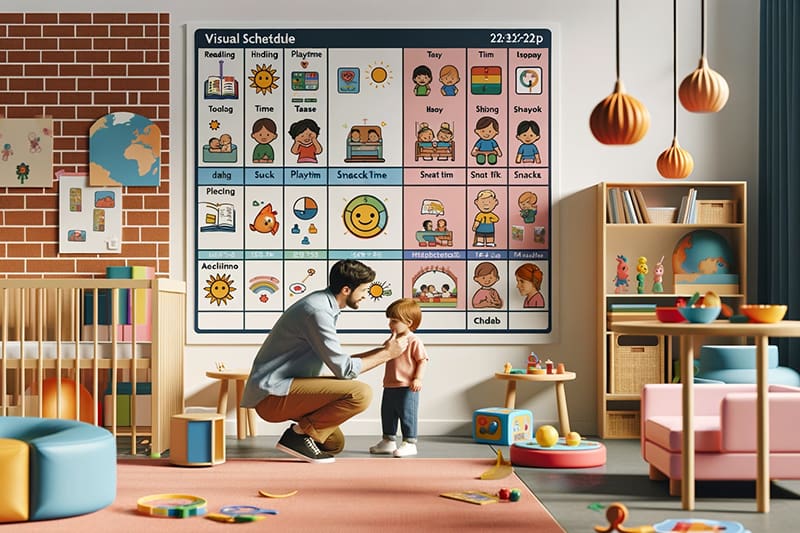Why Visual Schedules are Crucial for Success in ESDM
The Early Start Denver Model (ESDM) is a leading therapy approach for young children with autism spectrum disorder (ASD). A key component of ESDM is the use of visual schedules. These simple yet powerful tools can significantly enhance communication, understanding, and engagement for children participating in ESDM therapy.
At Chicago ABA Therapy, we’ve seen firsthand the transformative impact visual schedules can have on a child’s progress. Let’s delve into why visual schedules are so vital for individuals in ESDM and how they contribute to positive outcomes.
What are Visual Schedules?
Visual schedules are communication tools that use pictures, symbols, or objects to represent activities, routines, or steps in a sequence. They provide a clear visual representation of what’s expected and what’s coming next.
For children with ASD, who often have strong visual processing skills, visual schedules can be more accessible and easier to understand than verbal instructions alone.
Why Visual Schedules Matter in ESDM Therapy
-
Reduce Anxiety and Increase Predictability:
Children with ASD often thrive on routine and predictability. Visual schedules offer a sense of security by making the day’s activities clear and predictable. This can significantly reduce anxiety and meltdowns. -
Enhance Communication and Understanding: Visual schedules act as a bridge between the child’s world and the expectations of the therapy session. They make instructions concrete and easy to grasp, promoting understanding and cooperation.
-
Promote Independence and Self-Regulation: With a visual schedule, children can learn to manage their time, anticipate transitions, and follow the therapy program with greater independence. This fosters self-regulation skills and builds confidence.
-
Improve Engagement and Participation: When children know what to expect, they are more likely to be actively involved in therapy activities. Visual schedules can capture and hold their attention, leading to increased engagement and participation.
-
Support Skill Development Across Domains: Visual schedules can be used to teach a wide range of skills, including communication, social interaction, play, and self-care. They provide a structured framework for learning and practicing new behaviors.
How Visual Schedules are Used in ESDM Therapy
At Chicago ABA Therapy, we create personalized visual schedules tailored to each child’s unique needs and interests. These schedules may include:
- Daily Routines: Pictures of getting dressed, eating breakfast, brushing teeth, etc.
- Therapy Activities: Symbols representing play, learning, and social interaction.
- Transitions: Images indicating movement from one activity to another.
We work collaboratively with families to ensure visual schedules are seamlessly integrated into the child’s home and therapy environments.
Chicago ABA Therapy: Your Partner in ESDM Success
If you’re considering ESDM therapy for your child, we encourage you to reach out to Chicago ABA Therapy. Our experienced team of Board Certified Behavior Analysts (BCBA) is dedicated to providing the highest quality care and support. We’ll work closely with you to develop a personalized treatment plan that includes the effective use of visual schedules to help your child reach their full potential.
Additional Tips for Using Visual Schedules in ESDM
- Make it interactive: Allow your child to actively participate in creating and using their visual schedule.
- Keep it simple: Start with a few key activities and gradually add more as your child’s understanding grows.
- Be consistent: Use the visual schedule consistently across settings to maximize its benefits.
- Celebrate success: Acknowledge and reward your child’s progress in using the visual schedule.
Ready to Learn More?
Contact Chicago ABA Therapy today to schedule a consultation and discover how our comprehensive ESDM therapy program, including the use of visual schedules, can make a positive difference in your child’s life.










